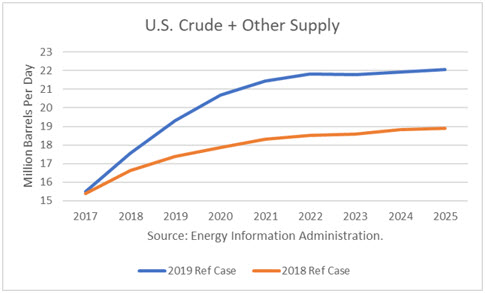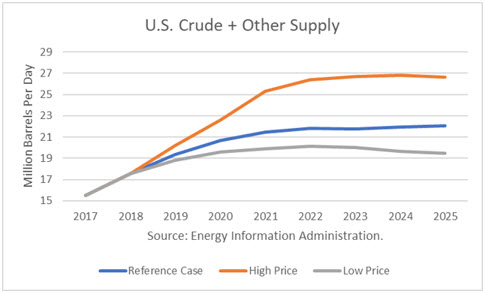The Energy Information Administration released its Annual Energy Outlook for 2019, and what a difference a year has made. Due to shale oil’s production response in 2018, EIA’s outlook through 2025 shows supplies surging.

The production forecast includes both crude oil and “other supply,” which will be explained in greater detail below. Often, U.S. production is generally limited to crude oil, but other liquids included in petroleum supply, have become a major component and are expected to rise even faster than crude alone.
Total liquids are projected to rise from 17.5 million barrels per day (mmbd) in 2018 to 22 mmbd in 2025 in EIA’s reference (base) case. In its high price scenario, EIA projects 2025 volume could be 26.4 mmbd. By comparison, Russia is producing just over 12 mmbd and Saudi Arabia just over 10 mmbd with its recent cutback. And so US output could be roughly the number two and three highest country volumes combined.

EIA is not alone in this forecast. Rystad Energy predicts U.S. production of 25 mmbd in 2025 if prices remain above $50.
One important implication of rising U.S. production is “oil independence” by the end of 2020. U.S. oil exports will exceed U.S. oil imports the aggregate. This will shift the U.S. balance of payments, supporting the dollar.
However, this does not mean the U.S. will cease importing crude or petroleum products. Trade will remain as producers and refiners optimize both their sales and refinery inputs.
Below is a technical discussion of the other supply included with crude in measuring production volumes.
"Dry" and "Wet" Natural Gas
There are two categories of natural gas produced: "dry" gas and "wet" gas. Dry gas is almost exclusively methane, which is a chemical compound of one carbon atom and four hydrogen atoms (CH4).
Wet gas, by contrast, contains compounds like ethane and butane, in addition to methane. These natural gas liquids (NGLS) can be separated and sold on their own. Ethane is an organic compound which contains two atoms of carbon and six atoms of hydrogen (C2H6).
Ethane and Ethylene
Prior to the 1960s, ethane and larger molecules were typically not separated from the methane component of natural gas, but simply burnt along with the methane as a fuel. But over time, ethane became an important petrochemical feedstock and is separated from the other components of natural gas in most well-developed gas fields.
Ethane is most efficiently separated from methane by liquefying it at cryogenic temperatures. Various refrigeration strategies exist, the most economical process of which can recover more than 90% of the ethane in natural gas.
It can also be separated from petroleum gas, a mixture of gaseous hydrocarbons produced as a byproduct of petroleum refining. Further distillation then separates ethane from the propane and heavier hydrocarbons.
The chief use of ethane is the production of ethylene by steam cracking. Ethylene is widely used in the chemical industry. Much of this production goes toward polyethylene, the world's most widely used plastic. It is primarily used to make films in packaging, carrier bags, and trash liners.
Ethylene is also produced from just about all parts of higher plants, including leaves, stems, roots, flowers, fruits, tubers, and seeds. It has been used since the ancient Egyptians, who would gash figs in order to stimulate ripening (wounding stimulates ethylene production by plant tissues). The ancient Chinese burnt incense in closed rooms to enhance the ripening of pears.
In modern agriculture, ethylene is an important natural plant hormone, used during certain stages of growth such as germination, the ripening of fruits, abscission of leaves, and senescence of flowers.
Petrochemicals
As with ethane, other chemical products are derived from petroleum or wet natural gas. Some chemical compounds can also be made from other fossil fuels, such as coal or natural gas, or renewable sources, such as corn or sugar cane.
The two most common petrochemical classes are olefins (including ethylene and propylene) and aromatics (including benzene, toluene, and xylene isomers). Olefins and aromatics are the building blocks for a wide range of materials, such as solvents, detergents, and adhesives. Olefins are the basis for polymers and oligomers used in plastics, resins, fibers, elastomers, lubricants, and gels.
Oil refiners produce olefins and aromatics by fluid catalytic cracking of petroleum fractions. Chemical plants also produce olefins by steam cracking of natural gas liquids such as ethane and propane. Aromatics are produced by the catalytic reforming of naphtha. Mixtures labeled naphtha have been produced from natural gas condensates, petroleum distillates, and the distillation of coal tar and peat.
Natural gas condensate is a low-density mixture of hydrocarbon liquids that are present as gaseous components in the raw natural gas produced from many natural gas fields. But some gas "species" will condense to a liquid state if the temperature is reduced to below the hydrocarbon dew point. This condensate is also referred to as natural gasoline because it contains hydrocarbons within the gasoline boiling range.
The most common petrochemical feedstocks are naphtha and light gas oil, which are derived from the oil refining process, and individual gases such as ethane, propane, and butane, which come from natural gas liquids.
Natural gas liquids are an integral part of liquid petroleum supplies. Non-crude inputs add several million barrels to refinery inputs and blenders. To ignore their production is viewing petroleum production too narrowly. Their production has been rising and is projected to continue to rise.
Fuel Ethanol (Alcohol)
Besides Natural Gas Plant Liquids, EIA's "Other supply" includes renewable fuels, the largest of which is ethanol. Henry Ford thought biofuels were the "fuel of the future." He said that alcohol is "a cleaner, nicer, better fuel for automobiles than gasoline." Ford imagined America could grow its own fuel, making it out of everything, from potatoes to sawdust.
Ford's vision of mass biofuel consumption began with his Model T Ford. Starting in 1908, the Model T propelled Ford Motor Company (NYSE:F) to become the largest producer of automobiles at the time. By 1918, over half of the cars in America were Model Ts.
From its original design, the Model T ran on ethanol as well as gasoline. The Model T had a knob right on the dashboard to adjust the fuel-air mixture for either alcohol or gasoline.
In the United States today, ethanol is blended with gasoline, contributing about 10% to the fuel supply. Ignoring ethanol's contribution to fuel supply is therefore incorrect.
Refinery Processing Gain
The final category in "other supply" is refinery processing gain, the volumetric amount by which total output is greater than input for a given period of time. Technically, this is not another source of supply, but rather, is the result of the refining process. This difference is due to the processing of crude oil into products which, in total, have a lower specific gravity than the crude oil processed.
Conclusions
The market is fixated on the U.S. crude oil production only. However, "Other supply" has risen substantially and is integral to the petroleum supply. The trend in crude plus other supply is what matters, and the EIA is estimating total production in the U.S. to dominate the world’s supply.
Check back to see my next post!
Best,
Robert Boslego
INO.com Contributor - Energies
Disclosure: This contributor does not own any stocks mentioned in this article. This article is the opinion of the contributor themselves. The above is a matter of opinion provided for general information purposes only and is not intended as investment advice. This contributor is not receiving compensation (other than from INO.com) for their opinion.

Nice to see the Ministry of Plenty doing its job.